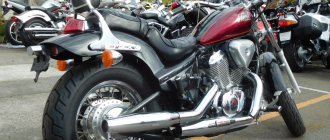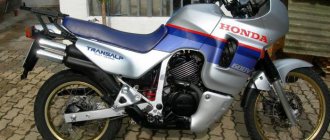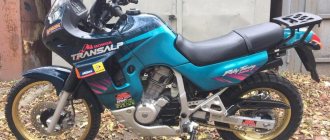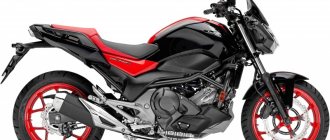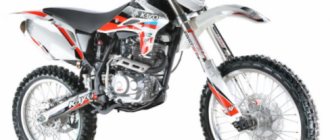The XR series of motorcycles consists of the following models: Honda XR 250, Honda XR 250 Baja, Honda XR 250 R, Honda XR 250 Motard. Honda XR 250 is the base model. In contrast, the Honda XR 250 Baja has a larger gas tank and dual headlights. Honda XR 250 R is an export model weighing 116 kg, which does not have an electric starter or aggravating elements. The supermoto-focused Honda XR 250 Motard features road wheels, firmer suspension and a beefier front brake.
Analogues and competitors
The main competitors of the Honda 250 model are the following enduro motorcycles:
- Suzuki Djebel-250 XC and GPSver are universal models suitable for the city and off-road, but the level of cross-country ability is low;
- Suzuki DR-250R and Suzuki DR-250 are lightweight and durable motorcycles on difficult trails, but owners complain about insufficient lower traction;
- The Yamaha TT250R Raid is a station wagon, so this model does not have any special advantages; it is most often put on a par with the Honda XR 250 Baja, but, unlike the latter, it is not designed for difficult routes and jumps - the suspension will not hold up;
- Yamaha XT225 Serow is a light, passable, low motorcycle that is perfect for beginners, there are no negative reviews about it; with a power of 20 horsepower, this unit has good traction, which allows it to be used effectively in the mountains;
- Kawasaki KLX-250S is a motorcycle more suitable for riding on asphalt at low speeds.
- Honda ftr 223 - takes worthy attention in the motor market and attracts with its price.
It is worth noting that in terms of reliability of parts and structures, motorcycles from other companies are much inferior to the Honda XP 250 model range.
Advantages and disadvantages
The main advantage of the Honda XR 250 motorcycle is that it can be used for motorcycle touring in extreme conditions. As a matter of fact, it was designed for these purposes. Achieving optimal layout and balance is ensured by the following characteristics of the motorcycle:
- Long travel suspensions.
- Ease.
- Excellent quality even after forty thousand kilometers in Japan.
- Availability of lighting equipment and trip computer.
- Unsurpassed maneuverability, which is achieved through a well-thought-out design. The presence of a short base and a sharply installed fork.
- Good traction at the bottom.
- Wide range of engine capabilities, combined cooling.
- Ideal oil supply system. Moreover, in extreme cases, low-quality oil can be poured.
- Possibility of deep tuning.
Such characteristics of the motorcycle allow it to overcome significant heights and fit into the tightest turns.
Among its analogues, the Honda XR 250 is considered the most popular motorcycle because of its undeniable advantages: reliability, lightness, cross-country ability. It was on this enduro that an athlete from Hungary set a world record (still unsurpassed) when conquering a height of 6183 meters in the Himalayas.
Honda's disadvantages include:
- Small headlights. If you need good light, then it is better to choose the Honda XR 250 Baja model with additional large headlights.
- Use of original spare parts in repairs.
- High price.
- The electric starter can become sour when the car is idle for a long time.
- When used in harsh conditions, clutch discs wear out quickly.
- Slow acceleration.
- Suitable for solo riding only.
- No wind protection.
- Not suitable for short people.
MotoReview No. 12, 2007
Honda XR250 Motard: 249 cm3, 28 hp, 130 km/h, 120 kg, 150,000 rubles
Supermoto is the youngest type of motorsports and, accordingly, a class of motor vehicles. The first home-made developments appeared in the mid-80s; after five years, even some semblance of championships in this class was formed, but as for serial developments, it came to them quite recently. For a very long time, the leading motorcycle manufacturers did not want to notice motards, and then they tried to solve this problem with little effort (by simply “changing shoes” of serial enduro tires into road tires), but in the end, what happened was what should have happened - supermotos of various cubic capacities and degrees of “charge” are now available in the “stables” of almost all famous companies. And some even made the production of such cars their signature feature. But at the same time, each manufacturer had its own view of the class. Japanese Honda, for example, did not see any promise in it for quite a long time. It traditionally carried out its global marketing activities in this direction first in the domestic market. It was for this purpose that the small but remote XR250 Motard was introduced in the spring of 2003. The recipe for creating a model couldn’t be simpler. The enduro XR250 has been produced in Japan since the early 90s, has been tested for strength and has proven itself in terms of endurance and reliability. In addition, the device is distinguished by its low weight (119 kg) and a super-reliable 28-horsepower single-cylinder air-cooled power unit. Another important point was that the Japanese, who were avid for European motorcycle fashion, often converted the enduro XR250 into a supermoto on their own and successfully. The designers actually only had to put their achievements into official terms. But instead of slightly boosting the engine, radically changing the suspension and making the design more provocative, the developers limited themselves to minimal modifications such as new smaller wheels (110/70-17 in the front and 130/70-17 in the rear) with road tires. The power unit settings and wheelbase remained unchanged. Judge for yourself: in comparison with the basic enduro, the supermoto version seems to have shrunk (the length, width and height of the enduro and motard, respectively: 2.175 × 0.805 × 1.190 and 2.110 × 0.790 × 1.150 mm), the seat height decreased by 20 mm to 855 mm, the road clearance (up to 240 mm) and the weight of the machine increased by a kilogram. Thus, due to minimal reconfigurations (and it’s difficult to call it a rework), the model acquired a so-called fan factor to the slight detriment of dynamic characteristics. However, the consumer didn’t really notice this. Honda presented the supermoto in a cheerful coloring - this was enough for consumers to start buying up new products with excitement. Surprisingly, with minimal differences from the enduro version, the supermoto version became more popular, which led to the fact that in 2004 the company decided to carry out a slight restyling of the appearance and released a modest catalog of accessories, including all sorts of fashionable things for the external design of the model. Nobody considered the 250cc model as a serious player in the market of “charged” and sports supermotos. On the contrary, it was accessibility (both price and consumer) that became the key factor for the Honda XR250 Motard to quickly become a market bestseller. If the enduro XR250 implied a “narrow specialization,” then the motard was bought by all those who preferred to move around the city and surrounding areas on a fashionable motorcycle. It is the popularity of the model in the domestic market that determines the high cost of the motorcycle in the second-hand category. But this point does not interfere with the fact that they are still represented in quite large numbers in Russia. Enduro Honda XR250 is very popular in our country. How are we doing with the XR250 Motard? Let's give the floor to the experts. Alexander Astapov, Deputy Editor-in-Chief of Motor Review Height – 182 cm, driving experience – 15 years, rides a Yamaha Majesty 400 and Italjet Dragster XX Oh, that’s my size! 120 “dry” kg (“equipment”, respectively, 134) is quite a scooter value, the width is generally like that of a moped. The base, however, is too big for a scooter, as much as 1425 mm, but on this fence, in principle, there should be no special need to turn - in theory, it will squeeze between the streams of rain. And for everything about 28 forces - not bad, at least not a single scooter has ever dreamed of such a ratio. And therefore, in the funeral procession called “working afternoon on the Moscow Ring Road”, this anti-scooter is like a fish in water. You’re welcome to bludgeon along the “lane for motorcyclists” along the dividing barrier, and you don’t even have to slow down in front of those who like to stand on it with their four bast shoes (apparently in the hope of seeing when it will end). He ran into a member of the truck with “flashing lights”, scaring everyone away in the hope of getting through first - God bless him. Several non-aggressive but quick maneuvers into the right aisle, a little along it, then back - and the black “Hitlerwagen” is not visible even in the mirrors. Yeah, so the cork has dissolved. The fourth, fifth... The accelerator is more than peppy, but after 100 it goes out, and by 130 it’s all waking up! And where is 28 forces? Similar behavior at three-digit speeds is the norm for the Derbi GP1 250 with its 21 horsepower and variator, but here there are a third more “mechanics”! Hey, where are you, my seven fast-paced trotters? You can’t fool physics: the “forehead” here is like on a “big” endura, and the aerodynamics are no better than those of the MTZ-80. And if it’s not so bad during the day, then in the evening you have to look in the mirror almost constantly. And wait, like manna from heaven, for the life-saving exit from the Moscow Ring Road into the city, where the speed limit is much softer, and the capabilities of the XR250 fully correspond to it. And the capabilities of the chassis correspond not only to capital highways, but also to broken-down “designed driveways” in industrial zones, where the asphalt has not been changed, probably since the era of glasnost and acceleration. Acceleration? Yeah, I was dreaming: on the sharp edges of asphalt gullies, planting a hernia on low-profile tires is a piece of cake. But where there are no potholes - even on cracked concrete, even on the dirt roadside - there is grace. At least turn 80! Just don’t forget to lift your butt off the perch, misunderstoodly called a saddle. And have a reserve on the handle to unload the front wheel when you see a track from a DT-75 or other iron muck suddenly appearing along the course. Difficult? Well, it’s easier than barely crawling through such a minefield on a scooter! Should I buy one for myself? Alas. Most of the way to work I drive along the Moscow Ring Road, and there the “four” clearly lacks the “maximum speed”, which is fraught. Start commuting to work through the center? Oh no not this! Entuziastov, TTK, Leningradka - along its entire length this route is one continuous “traffic jam”, and impassable even on an XR250 (you only feel normal there on a pit bike). If only some areas, but there the basic version would be better, on normal Enduror wheels. They will make it easier to run away from a motorcycle battalion, if anything happens (mega-fines for driving on sidewalks have already been introduced, if you don’t know). But even with this version you won’t be able to escape from being chased, say, in the Lefortovo Tunnel – from a BMW! The engine is not enough, even the XR650 won’t get you going. But the “-650” weighs much more, with my frail carcass you won’t be able to fly around the park, curbs and other lawns on it... In general, wherever you throw it, there’s a wedge everywhere. And yet, I understand those of my friends and acquaintances who consider the 250 cc Endura to be the best “single-track vehicle” (not everyone lives in such a... hmm... anomalous zone as I do!). As for the supermoto version, it seemed to me that it was good for more powerful models. Where the issue of controllability on asphalt due to, let’s say, slightly higher speeds is really acute. Vladimir Zdorov, Motor Review expert Height – 193 cm, driving experience – 15 years, drives a BMW K1200R Sport Small, nimble and agile, like an ever-preoccupied hamster trying to mate even with a sock that hasn’t been washed for a week, the XR250 is in the supermoto category, in fact, is a very highly specialized, strictly targeted melee weapon. Under my dimensions it is practically invisible. Outside observers may have the illusion that a big and angry adult uncle took the moped from a teenager and, without any embarrassment, heaped his almost 100-kilogram carcass onto the frail, fragile body of the unfortunate Honda. Perhaps the latter will even be somewhere not far from the truth... But what’s interesting is that this runt rides surprisingly vigorously, however, only up to 100 km/h, where the engine completely fades out, followed by death. That is, the territory from 100 km/h and above is clearly not for the XR250, although with some luck and perseverance the speedometer can be raised to 130 km/h, but you are unlikely to feel any joy from this. The engine will work at the limit of its capabilities, appealing to your mercy through serious vibrations and a completely adult appetite, both gasoline and oil. In general, the engine for my weight here, whatever one may say, will not be enough. And in such situations you will have to turn, and quite often. So, obviously, the fun for this microbe must be looked for elsewhere. What? In driving along underground or, as an option, overground pedestrian crossings, in honing or simply learning the basic skills of stoppie and wheelie. By the way, about wheelie. With such a puny engine, it is only possible in first gear, and for any prolonged movement on the rear wheel you will need good balance driving skills and the ability to shift without a clutch. Moreover, you will have to shift at least twice, up to the third gear, otherwise the short second one will force you to “land” after 100 meters... So, as a training device, the device seems extremely interesting for advanced users who want to learn basic stunt riding skills. It is here that the small engine power will require maximum skills from its owner, while more powerful motorcycles will “ride” precisely due to the power unit. Don’t forget about the model’s enduronic roots, which mean amazing durability in the event of falls. And here’s another important thing: since this is a Honda, this kind of exercise will not affect the “health” of the motorcycle in any way. The dry sump lubrication system allows for painless engine operation in an almost vertical position, so you can indulge in voluptuous wheelie for as long as you wish. Probably, the XR250 will also be interesting to the timid “beginner”, fearfully hiding his fat body in motorcycle protection, and cowardly looking towards the motorcycles. Especially if the latter had never had a two-wheeler before. But for a lover of plastic-rice rockets or (God forgive me) at worst, powerful naked bikes, the Honda XR250 in the Supermoto version seems like a rather dubious pleasure, I would say, not convincing - it’s completely unclear what I should do with it. So no thanks. Nikolay Bogomolov, Motor Review expert Height - 181 cm, driving experience - 9 years, rides a Suzuki GSX-R1000 and a Yamaha YFM700R The fashion for supermotards does not allow motorcycle manufacturers to sleep peacefully. Some try to create original models, others follow a more traditional path: they take a popular enduro and, through minor changes, transform it into a purely asphalt model. In recent years, motards of this kind have proliferated with terrible force, and of all this livestock, only a few are of real interest. Honda took the easy route. The Japanese did not bother with such nonsense as modifying the suspension and changing gear ratios. The new generation XR250 simply got 17-inch wheels and added the word Motard to the name. Of course, I suspected that nothing outstanding would come of such a modification, but when I saw the motorcycle in person, I was a little shocked. Asphalt use implies an increase in the power of the braking system. The same small front disc is present here, which is not always enough even off-road. Apparently, the manufacturer decided that the braking potential should be enough for such a modest motor. Naturally, “saving on matches” did not lead to anything good. Despite the light weight and far from prohibitive speeds, the brakes do not work well. The suspension doesn't behave well either. Still, the off-road performance is good for off-road conditions, but on asphalt the motorcycle sways like a scow in a storm. But that's where the bike's shortcomings end. One undoubted plus follows, oddly enough, from the above-mentioned minuses. The device remains the same wonderful enduro. And the owner, if he suddenly wants to go off-road, will only have to purchase wheels from a regular XR250. Perhaps rearranging wheels in the summer is not the best thing, but in winter it is quite possible to install “spikes” and fight motor toxicosis. In fact, the usefulness of 17-inch wheels in this case is generally in serious doubt. I remember that I rode quite a lot around the city and the nearest Moscow region on the enduro modification of the XR250. I can't say that I felt any discomfort. On the contrary, all the parts of the motorcycle were in harmony with each other. Endurance tires on large wheels were ideal for the soft suspension and weak engine. You could easily jump on a curb, slide down a flight of stairs, or take a shortcut through the forest. With the Motard version, all of the above procedures are no longer so easy to perform. I was completely afraid to drive onto the stairs with reduced ground clearance. You have to be careful with unpaved roadsides: road tires slip on them, and small wheels have difficulty swallowing potholes and bumps. The only serious plus, apart from the possibility of installing unnecessary sports tires on this motorcycle, is the low seat height. For some this may be relevant, but with my growth I don’t feel the need for such a reduction. So there is only one conclusion: they took a good motorcycle and ruined it. Mikhail Lapshin, deputy editor-in-chief of Motorreview Height - 193 cm, driving experience - 13 years, rides a Yamaha TDM900 Cool thing, but it’s a pity that it’s designed for weightless Japanese. From the outside, the motorcycle looks like a horse, but if you sit on it, it turns into Eeyore. I started testing this motard in full confidence that I wouldn’t be able to ride it for a long time. I looked really funny: I folded my limbs almost in half - well, a grasshopper is a grasshopper! Surprisingly, this baby easily carried my 90 kg forward. And I didn’t even notice how I hit “hundred”, the motorcycle accelerated further, but it was already scary. As a result, out of habit, I began to make my way into the left lanes of the Moscow Ring Road and suddenly realized that I simply could not maintain the pace of 120–130 km/h. The gas was on full, there was no acceleration reserve, the brakes were sluggish... In general, I had to move towards the trucks, into the right lanes, where I was completely lost among their giant trailers. Of course, this is Honda, only this company produces motorcycles that amaze with the perfect performance of everything that is necessary for movement. The gears are switched on easily and clearly, all the buttons and toggle switches are at hand, or rather, under your fingers, everything is visible in the mirrors, nothing gets in the way or irritates. I admit that after 5 km along the ring road I no longer wanted anything except one thing - to go back and give the device back. But as soon as I entered the city and encountered the almost round-the-clock traffic jams that have become traditional lately, my mood began to improve. The width of the motorcycle, the position of the mirrors, and the overall handling make riding in the city easy and relaxed. Not a single large motorcycle can compare with it in climbing between cars, and perhaps a scooter can still compete, but not every scooter can accelerate so quickly and climb curbs. And when riding on a “stool,” you sit much lower, which means you have less control over the situation. Motorcycle for courier services? To the point, this is exactly the type of device I would recommend purchasing in batches. Model for a beginner? Please accept my best recommendations. After all, having all the qualities of a lightweight enduro (energy-intensive suspension, light weight, ease of control, etc.), it also stands perfectly on the line, sticks to the asphalt in corners and is generally easy to control. With this, you can easily disrupt public order by storming, if anything, underground passages. Yes, and on the Moscow Ring Road you can trot along the overpass. A fall on it will not greatly affect your expenses. The motorcycle is good for many things, but one cannot fail to mention its shortcomings. First of all, there is a tendency for the brakes to overheat. Still, one 260 mm disk at the front is not enough at all... You have to always connect the rear one, which, by the way, is quite large - 210 mm. But still, when driving aggressively, there is some looseness. The temperamental engine dies out almost instantly after 100 km/h, but you don’t want to feel like a scooter in traffic. The motor is quite noisy and under such loads requires careful and regular maintenance. What's the end result? There is a good city motorcycle with a supermoto design. In a city like this, traffic jams are still good, but when they are gone, it’s not so good. The route is closed on highways and highways. In general, it turns out that the device is very limited
Reviews
For the most part, judging by the reviews of bikers who rode enduros from different companies, Honda remains the undoubted leader. Users note the ease and convenience of operation, as well as the excellent quality of parts and overall design.
Operating experience. If you compare motorcycle experience stories from different users, they all say the same thing:
- behaves well off-road;
- in case of falls, almost everything remains intact or requires minor repairs, that is, the reliability of the structure is confirmed repeatedly;
- Users get great pleasure from the ride.
If for some reason bikers have to sell a Honda, then regret arises for everyone without exception.
Dimensions and weight
The curb weight of the bike is 120 kg. Its tank capacity is 9.7 liters, while fuel consumption per 100 km of road averages 4 liters. The rear tire dimensions are 130/70-17, and the front tire dimensions are 110/70-17. All this suggests that the bike is perfect for connoisseurs of light, maneuverable machines.
Tuning
Tuning of Honda XR 250 motorcycles is most often used to improve performance and increase service life for off-road riding. To improve a motorcycle, they most often turn to specialists. The most used tuning elements:
- arcs and slides - to improve the strength of the structure, they are installed by welding;
- brakes made of composite materials to improve their sensitivity.
Appearance is also an important tuning detail. Various elements are used to decorate a motorcycle:
- front fender extension;
- side stand stands;
- protection of hands and control levers;
- protection of telescopic fork stays;
- protective anthers;
- steering wheel cuffs;
- universal palm-mounted cruise control;
- heated covers and grips;
- LED turn signals and adapters for them;
- mirror expanders;
- platforms for wardrobe trunks.
The design of the motorcycle can also be chosen to suit every taste. Airbrushing is very popular.
Chassis and brakes
The frame of the XR 250 is made of steel. In appearance, this is a typical motard, somewhat reminiscent of a motocross motorcycle. The wheels are spoked. Since the landing is quite upright, the steering wheel is appropriately wide. This is generally a characteristic feature of the class.
The rear suspension travel of the XR 250 is 220 mm. This is a progressive monoshock. At the front, the suspension with a travel of 240 mm is an inverted fork with dimensions of 43 mm. The rear brakes are a single 220 mm disc, assisted by a single-piston caliper. The front brake is also served by a single disc, but its size is 260 mm, and it is supported by a two-piston caliper.
Repair Honda XR 250
If any element of the motorcycle fails, replacement should only be made with an original spare part.
If the engine malfunctions, drivers recommend not changing it completely, but replacing those parts that have failed. It may not be cheaper, but it’s definitely more reliable. Operating experience shows that with timely oil changes (every 2000-5000 km), the engine will last for a very long time without repair.
When using enduro on rough terrain, special attention should be paid to suspension elements, wheel bearings and progression links.
Operation in non-aggressive conditions requires replacing spark plugs, filters and oil once a season.
All fastenings are strong, large and do not raise any questions during repairs even for beginners. The valves require adjustment once a quarter.
Timely diagnosis and replacement of faulty Honda parts will lead to long-term operation of the motorcycle without breakdowns or accidents.
The Honda XR250 is an excellent, and most importantly, reliable and high-quality choice for both beginners and professionals.

